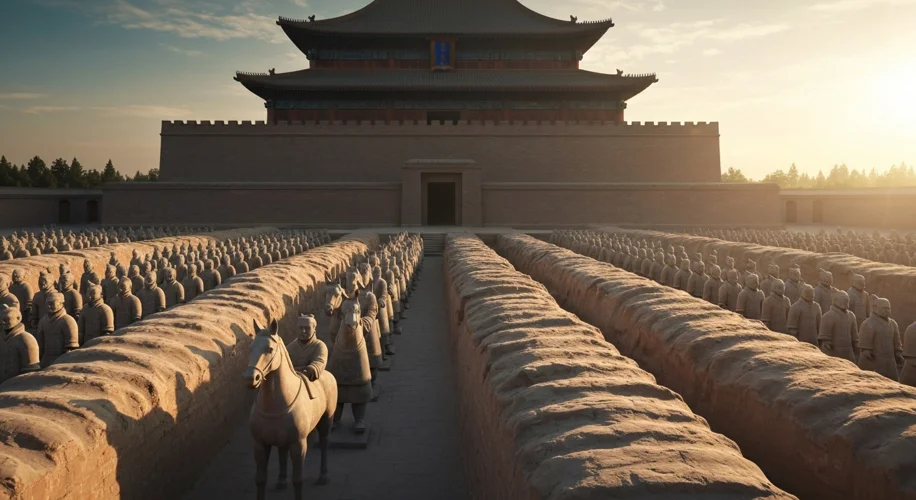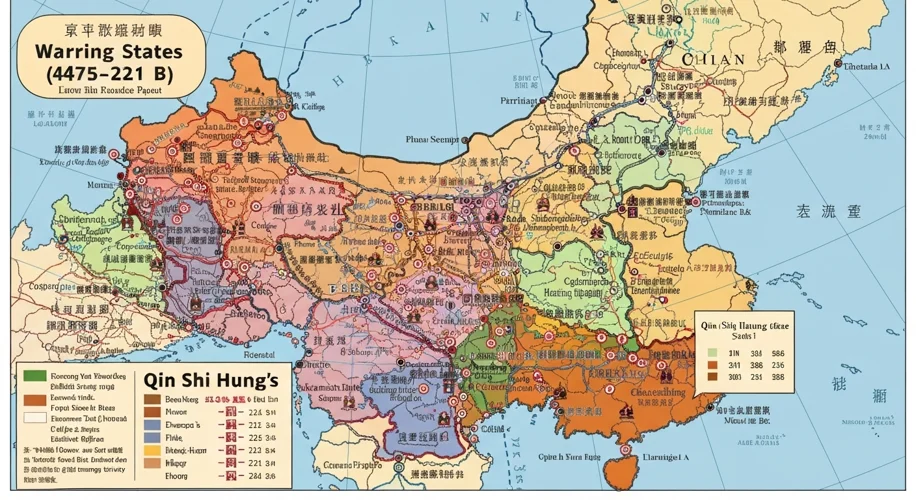The year is 221 BCE. For centuries, the land we now know as China has been a fractured mosaic of warring states, each vying for dominance. The air hung heavy with the dust of countless battles, the cries of soldiers, and the anxieties of common folk caught in the endless churn of conflict. This was the Warring States period, a brutal era that seemed destined to last forever. But then, from the west, a force emerged, a state known as Qin, driven by an ambition as vast as the Yellow River itself, and led by a figure who would forever etch his name into history: Qin Shi Huang, the First Emperor.
Picture this: the state of Qin, once a peripheral kingdom, had systematically conquered its rivals. Its success wasn’t by chance. The Qin state had embraced radical reforms, largely inspired by Legalist philosophy. This school of thought emphasized strict laws, harsh punishments, and an all-powerful central government. Unlike other states that relied on traditional aristocratic hierarchies, Qin focused on meritocracy, rewarding farmers and soldiers who contributed to the state, and punishing corruption and inefficiency with brutal efficiency. Their military was a well-oiled machine, disciplined and technologically advanced for its time, utilizing iron weaponry and sophisticated tactics.

The key actor, of course, was Ying Zheng, the future Qin Shi Huang. Born into royalty, he ascended the throne of Qin at a young age. He was a man of immense will, a visionary, and a ruthless pragmatist. His primary minister, Li Si, was a brilliant Legalist scholar who provided the intellectual framework for Qin’s rise. Together, they envisioned a unified China, a single empire ruled by a single, absolute monarch. Their perspective was one of order above all else; chaos was the enemy, and unity, enforced by unyielding law, was the only path to stability and prosperity.
On the other side were the rulers of the other six major states: Han, Wei, Zhao, Yan, Chu, and Qi. They represented a more traditional, often feudalistic order. While they possessed formidable armies and rich cultures, they were often plagued by internal divisions and a failure to adapt as quickly as the Qin. Their perspective was one of self-preservation, each state jealously guarding its autonomy against the encroaching power of Qin.
The unification itself was a brutal, decade-long military campaign. Starting in 230 BCE, Qin systematically dismantled its rivals, state by state. The final conquest came in 221 BCE, when Qin annexed the state of Qi. With the last rival state subdued, Ying Zheng declared himself Qin Shi Huang – the First Emperor of a unified China. This was not just a political unification; it was a cultural and administrative revolution. The emperor immediately set about standardizing everything. Weights and measures were unified, currency was standardized, and crucially, the script used for writing was unified across the empire. Imagine the chaos of having different written languages in different regions; this standardization allowed for efficient communication and governance.

The consequences of this unification were profound and long-lasting. Qin Shi Huang’s reign, though relatively short, laid the foundations for over two millennia of imperial rule in China. The administrative structure he implemented, with a centralized bureaucracy and standardized laws, became the model for subsequent dynasties. He initiated massive infrastructure projects, most famously the precursor to the Great Wall of China, connecting existing fortifications to defend against northern nomadic tribes. He also standardized the axle widths of carts, making travel on the newly built roads more efficient.
However, his methods were often tyrannical. The Legalist approach meant harsh punishments, forced labor for public works, and the suppression of dissent. Books that contradicted Legalist ideology were burned, and scholars who opposed the regime were executed. This period of intense centralization and control created significant hardship for many.

Analyzing Qin Shi Huang’s legacy is complex. He was a visionary who brought an end to centuries of bloodshed and laid the groundwork for a unified Chinese civilization. His administrative and infrastructural achievements were monumental, shaping the very identity of China. Yet, his reign was also marked by brutal oppression and a disregard for individual liberties. The First Emperor created a powerful, unified state, but the human cost was undeniably high. Little did those living through the Warring States period know that the harsh, yet effective, measures of Qin would forge an empire that would endure, in various forms, for thousands of years, leaving an indelible mark on the world. The echoes of his unification still resonate in the China of today, a testament to the enduring power of both order and ambition.

